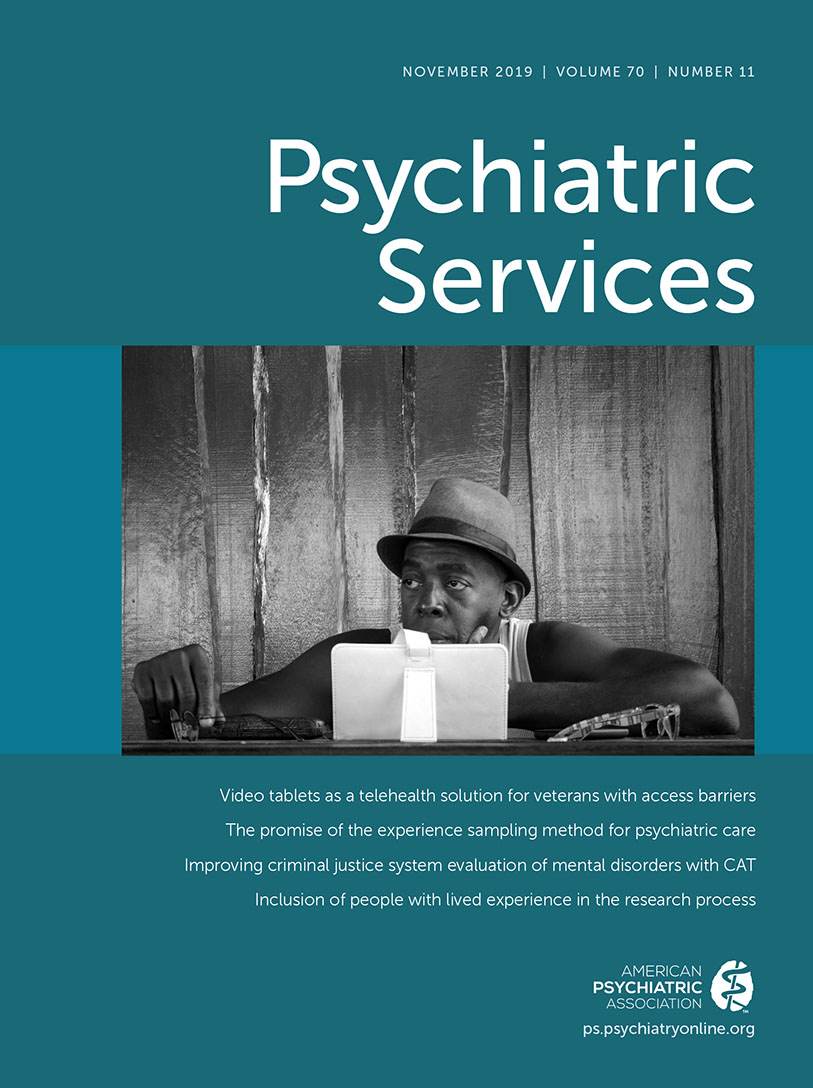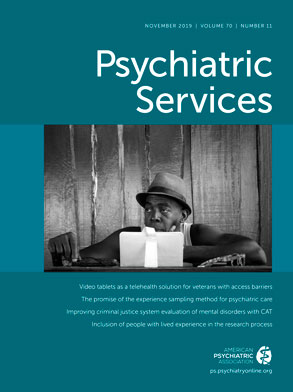The burden of mental health and addiction (MHA) is significant (
1), and literature indicates that the number of patients seeking treatment for related conditions has increased significantly in recent years (
2,
3). In Canada, recent provincial population-based evidence suggests a growing reliance on the acute care system to meet MHA needs; outpatient visit rates have declined, and rates of MHA-related emergency department (ED) visits and hospitalizations have both increased (
3). Examples of excessive demand for acute MHA services can be found internationally, particularly in countries in which the inpatient bed complements fall below the Organization for Economic Co-Operation and Development (OECD) average (
4), including in the United States (
5), Australia (
6), and England (
7). When demand outstrips supply, hospitals often increase the risk threshold for admission. This practice can exacerbate the symptoms of unadmitted patients, decrease the proportion of the total help-seeking population in need of care who ultimately receive it, and create less safe and less effective acute care environments (
8–
10).
Growth in demand for acute care has generally not been accompanied by comparable increases in inpatient bed capacity, despite international appeals (
11,
12). Beyond bed increases, ED expansion has been proposed to help meet the growing demand, and several examples in the literature explore the impact of expansion on demand and on indicators of patient flow (
13,
14). The merit of this approach is unclear; results are mixed, and unintended consequences, such as higher-than-expected ED volumes and wait times, have been observed.
In Toronto, Canada’s largest city, there have been no significant increases in acute MHA inpatient bed capacity, despite evidence of growing demand (
3). In central Toronto, acute MHA care is provided by seven public hospital–based services, all affiliated with the University of Toronto: one specialized MHA hospital (hospital S), four academic health sciences centers (hospitals A, B, C, and D), and two community hospitals (hospitals E and F). In November 2014, hospital S was renovated, doubling the space in its specialized psychiatric ED to address overcrowding and accommodate its rising number of visits.
The objectives of this study were to assess recent growth in demand for acute MHA care and examine new demand and patient flow at the hospital and service system levels following the expansion of a psychiatric ED in a large urban center.
Methods
A retrospective pre-post design and administrative data were used to identify all seven hospitals’ records of general ED visits and MHA ED visits between April 1 2011, and March 31, 2018. Only aggregated monthly totals were used, so approval from a research ethics board was not required.
Using the National Ambulatory Care Reporting System (NACRS), hospital decision support departments identified total monthly ED visit records. MHA ED visit records were identified as visits that involved a primary diagnosis of a mental health or addiction problem, based on the International Classification of Diseases, Tenth Revision, Canada (ICD-10-CA), or that involved an MHA intervention in the ED.
Records of admissions to acute adult MHA inpatient units were identified in the Canadian Institute for Health Information’s Discharge Abstract Database, based on applicable diagnoses consistent with the ICD-10-CA, and in the Ontario Mental Health Reporting System, based on the DSM-IV and/or individual hospital records.
Population data for central Toronto were obtained from Statistics Canada and Ontario’s Ministry of Finance. Cubic splines were used to interpolate monthly values from 2011 to 2018 based on annual population estimates.
To characterize trends in demand over time, crude differences between 2011–2012 and 2017–2018 were calculated, and change over time was modeled statistically to quantify broad, seasonally adjusted trends and to test for differences in underlying processes. Negative binomial regression models were fit for each outcome, with dummy-coded variables for hospital and month of year. Time was treated as a continuous variable, and population-adjusted models included person-days as an exposure variable, based on the population and the length of the relevant month.
To test whether the expansion of hospital S’s psychiatric ED was significantly associated with changes in hospital- and system-level MHA ED patient flow, two-part linear spline models were fit. Separate slopes were estimated for the periods before and after November 2014. Linearity of splines was examined by considering predicted and observed values and by attempting to fit fractional polynomial models. Postestimation procedures were used to test for differences between slopes.
In April 2017, hospital S reorganized its reporting structure to include additional units under its Acute Care Program portfolio. Models for admissions addressed this change by adding an indicator variable for all data reported by hospital S after the reorganization, effectively allowing the intercept to shift at that point in time.
The statistical analysis was conducted with Stata, version 14.
Results
Systemwide, general ED visits grew by 14.7%, from 443,911 in 2011–2012 to 509,028 in 2018; MHA ED visits grew by nearly twice as much, at 29.2%, from 37,737 in 2011–2012 to 48,741 in 2017–2018. The total number of annual admissions to acute adult MHA inpatient units from the ED increased minimally, by 4.0%, from 6,154 in 2011–2012 to 6,403 in 2017–2018.
Model results indicate that from 2011–2012 to 2017–2018, each year was associated with a 3.5% increase (95% confidence interval [CI]=3.2%–3.9%, p<0.001) in total population-adjusted MHA ED visits across central Toronto, rising from 258.5 monthly visits per 100,000 people at the beginning of the study period to 329.5 monthly visits per 100,000 people by the end of 2017–2018. This MHA ED visit growth rate was 1.7 times that of general ED visit growth (incidence rate ratio [IRR]=1.021, 95% CI=1.019–1.023, p<0.001). Across the system, the number of admissions to acute adult MHA inpatient units from the ED per MHA ED visit decreased by 4.5% per year (IRR=0.955, 95% CI=0.948–0.962, p<0.001).
After hospital S expanded its psychiatric ED in November 2014, hospital S’s annual rate of growth in MHA ED visits per capita increased significantly, from 5.6% per year (95% CI=4.3%–7.0%, p<0.001) to 13.0% per year (95% CI=11.6%–14.4%, p<0.001) (change in slope: z=5.89, p<0.001). The relative difference between hospital S and the general hospitals increased by 9.0% (95% CI=6.0%–12.1%, p<0.001). The six remaining general hospitals collectively saw a significant decrease in their postexpansion per capita growth in MHA ED visits, from 3.2% per year (95% CI=2.3%–4.2%, p<0.001) to 1.3% per year (95% CI=0.3%–2.3%, p=0.011) (change in slope: z=−2.17, p=0.03). The greatest decreases occurred at hospital D and hospital A, the two hospitals geographically closest to hospital S (
Figure 1). However, for the system as a whole, the annual per capita rate of growth was nearly identical before and after the ED expansion: 3.7% prior to the expansion (95% CI=2.9%–4.4%) and 3.6% after the expansion (95% CI=2.9%–4.4%) (change in slope: z=−0.02, p=0.98).
Discussion
The results of this study depict a large urban public service system in which demand for emergency MHA services has significantly outpaced population growth and general emergency service demand over a recent 6-year period. Amid such rapid growth in demand, the expansion of a psychiatric ED at one hospital was significantly associated with a further increase in its MHA ED visit rate, an outcome consistent with past examples of ED expansion (
13,
14). However, visit growth rates decreased significantly at surrounding hospitals, especially the two hospitals in closest proximity to hospital S, indicating a shift in traffic rather than an increase in ED use for MHA needs across the whole local system. Together, these results did not provide evidence of a systemwide increase in demand. The system appeared to be at capacity; an expansion at any of the seven hospitals likely would have resulted in a shift in patient visits toward the expanded site and away from surrounding sites because of a perceived increase in accessibility. An intrinsic preference for specialized services could explain the observed shift in MHA patient concentration toward a specialized psychiatric ED or may have augmented such a shift. Further research is needed to investigate the mechanisms underlying such shifts in service use patterns.
The observed rate of systemwide growth in MHA ED visits and stagnant inpatient capacity suggest that a decreasing proportion of MHA ED visits is resulting in admission. Such growing pressure on acute care, unaccompanied by increases in acute inpatient bed capacity and appropriate outpatient capacity, may have negative implications for individual hospitals and the collective MHA service system. The Canadian Psychiatric Association (
8), the Australian Medical Association, the Royal Australian and New Zealand College of Psychiatrists (
6), the OECD (
10), and others have warned (
7,
9,
13,
14) that a lack of acute care capacity can lead EDs and inpatient units to reduce the average length of stay (LOS), increase the risk threshold for admission, or both. Such practices are associated with less safe treatment environments, poorer patient outcomes, and systematic neglect of a significant proportion of the population in need of care. Furthermore, for those with acute needs that are not considered severe enough for admission, acute ambulatory services that could alleviate pressure on EDs are often inaccessible or insufficient (
15).
The conditions revealed in this study likely reflect an increase in demand for acute MHA care that has not been adequately addressed by careful, systemic planning. Such planning might examine the supply of inpatient beds and acute ambulatory services that could aid in early intervention and diversion, such as urgent care centers, assertive community treatment, and mobile crisis intervention teams (
10). Further discussions and research are warranted to determine which settings and modalities are most appropriate and effective in meeting observed increases in need.
The retrospective observational study design precluded causal inference about how the system might have changed in the absence of the expansion or how other events could have contributed to the observed shift in traffic. The use of administrative data also posed limitations: definitions did not include secondary MHA diagnoses, likely resulting in underestimated demand, and high-quality LOS data that could help explain capacity dynamics were unavailable. Lastly, the results are rooted in unique local circumstances and thus may not be generalizable to other contexts but offer important insights regarding challenges in delivering access to acute MHA services.
Conclusions
This study contributes to growing evidence that demand for acute MHA care is rising rapidly and significantly, with concerning implications for quality of care. In the context of such overwhelming system-level demand, our results suggest that individual hospital responses such as ED expansions are unlikely to be sufficient. Approaches to hospital-level capacity planning that account for conditions within the broader service system may be warranted.
Acknowledgments
The authors thank the decision support teams at each of the seven hospitals included in this study for their assistance with data collection.


